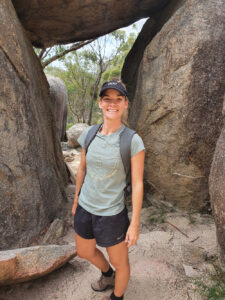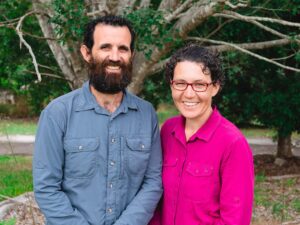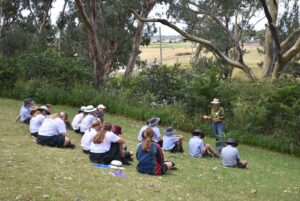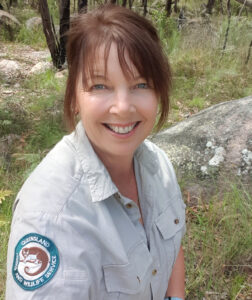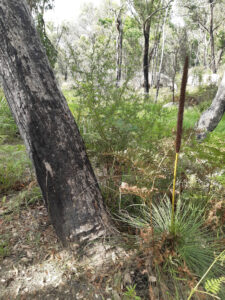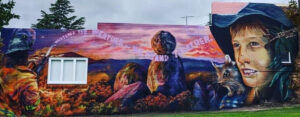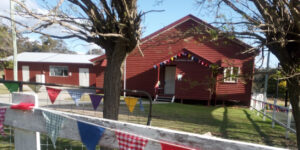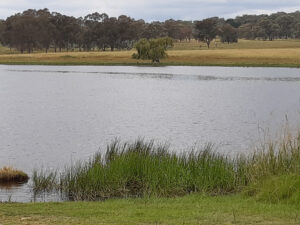Navigating Business in Tough Times with Julia Keogh from Warwick Chamber of Commerce
Transcript from the podcast “Speak Out Loud: Stories of Strength from the Southern Downs”
SEASON 2: EPISODE 4
GUEST: Julia Keogh, President Warwick Chamber of Commerce
PUBLISHED: 27th February 2022
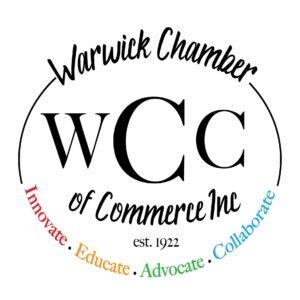
[00:00:00] Julia: At the end of the day, I think it comes down to the individual making a decision as to whether it’s going to be that old adage of a glass half full day or a glass half empty. If we as individuals start the day looking at opportunities and solutions, as opposed to the negative impacts that all of these challenges provide on a daily basis. I think that’s probably key. That we look at being solutions focused and take ourselves out of our comfort zones.
[00:00:42] Kathryn: I’m joined on the podcast today by Julia Keogh, President of the Warwick Chamber of Commerce. The Southern Downs Region supports a wide range of industries and businesses, including agri businesses, which feel the direct impact of events such as drought, bushfire, and flooding. In this conversation Julia shares practical ideas for business owners to manage their preparation for, and their recovery from adverse events, such as these as well as the impact of COVID-19. I hope you’ll be inspired for the future and enthused to take action after listening to this episode with Julia.
Hello, Julia. And welcome to the podcast. Can you talk to our listeners about what your connection is with the Southern Downs?
[00:01:32] Julia: Kathryn, thank you so much for inviting me to be a part of this really, really exciting project. As a local Warwick girl, Warwick and the greater Southern Downs Region is very, very close to my heart. I was born here at the Warwick Base Hospital let’s say 54 years ago and I’ve lived on our family property for, give or take, about 48 of those years. So I’m pretty connected to the region.
[00:01:56] Kathryn: You’re currently involved with the Warwick Chamber of Commerce amongst other organisations in the community. How did you first become involved with the Chamber of Commerce and what is your role there?
[00:02:09] Julia: I became involved with the Chamber, probably around 2012, 2013. So, while my children were growing up in Warwick I held a variety of different positions, but I also took on a role starting my own business as a commercial contract cleaner. And I found that I was really missing out on being able to connect with a lot of other local business owners that I guess I was engaging with on a daily or weekly basis. But it never got past that transactional relationship. And I really wanted to grow the business. I wanted to develop it. I was looking for some business mentors in town and my Mum actually said to me one day “Why don’t you join the Chamber of Commerce?” Up until that point, I’d been a sole trader for a long time. And I’d never actually thought that little old me as a sole trader could become a member a local Chamber of Commerce. I didn’t think I had the business experience or the nous to do it. Looking back now, I see how that fear and that hesitancy really did impede my ability to engage with a lot of fantastic local mentors. I ended up being brave and filling out the application form and, started attending some of the meetings. It resulted in a position coming up as Vice President, goodness, several years ago now. And, then the following year, the presidency was made vacant. And again, I guess I got brave and put my hand up. It was shaking a fair bit when I put my hand up, but I still did it. And so I’ve been involved now, since in the executive since 2016.
[00:03:48] Kathryn: Can you tell us a little bit more about the business sector in the Southern Downs Region? What types of businesses, commercial ventures and industries and services are operating on the Southern Downs at the moment?
[00:04:02] Julia: We have such a wide variety. Primary production is still our major economic driver in the Southern Downs. But then we’re looking at, you know, manufacturing is up there, the building sector, housing, all the way through to, well, I guess stemming from the agriculture, primary production and secondary production of goods and services. We truly have such a wide variety of business interests and experience that anyone looking at potentially relocating an existing business or starting a new business, the Southern Downs has so much to offer. We are resource rich. We are land rich. And now recently, after the most fantastic year of rainfall that we’ve had a very, very long time we now are getting back to starting to see some boom times, and as we’re sitting here, where we’re actually sitting in, in my front garden, which is not a garden anymore. It truly is a jungle. Just seeing the different growth that has come through from the rain is really reflective in what we’re seeing within our business sector, that we’re starting to see fresh opportunities, really blossom and bloom.
[00:05:17] Kathryn: And certainly the Southern Downs Region has been on a recovery journey. There have been successive events. I’m thinking of the bush fires in 2019 and 2020, but there was a severe drought that preceded that for several years. And more recently since the bush fires, we’ve had floods, we’ve had a mouse plague and as the rest of the world has also experienced, we’ve been experiencing this pandemic. So how have all of these events impacted local businesses and the business sector as a whole?
[00:05:51] Julia: It’s really interesting to look at how different, events shape a community. You and I’ve often discussed the difference between the immediacy of a fire event, a bushfire event, and how that’s in stark contrast to a creeping drought. So we look at what’s been happening over our region for the past 10 years since our last flooding events in 2010, 2011 to a 10 year drought, and just that stark contrast between the immediacy and the devastation of a fire, as opposed to continuing weeks months, and years of drought. Drought gets under people’s skins. It permeates. It’s a terrible thing for a regional community that relies on agriculture to have to go through. Our primary producers are well, well-versed and very, very used to it being fickle, but we do rely on cycles. And when those cycles don’t eventuate, it becomes incredibly eroding. It seeps into your pores and that, that feeling of despondency and desperation, whether or not people are aware, it creeps into the psyche of a community. Communities come together when we have events like floods and bush fires and communities start to fragment through drought. Now, if we look at the COVID impacts, we’ve been truly blessed across the Southern Downs to be in our own perfect little bubble for so long in that we haven’t truly been impacted. Looking at lockdowns and the impacts of lockdowns we’ve still had space to be able to get out and even if we do live in town and we have a unit or a small house, we’ve still had the capacity to be able to breathe fresh air, and go about life fairly normally. However, with the current variant Omicron and the need for people to be far more aware of social distancing and masks I guess it’s got real for us. My understanding is that we’ve got a couple of hundred cases across the Southern Downs with people who are in home quarantine and being cared for, my understanding is really, really well by our primary health providers. And now it’s our turn to step up to the plate and really show that resilience. I really feel that our COVID response is similar to drought in that it can fragment a community. And I’d really like to flip that and see people come together as we do in other natural disasters.
[00:08:24] Kathryn: How are the individual businesses dealing with COVID? Is that similar to how they dealt with, the impacts of bush fire, drought and flood? For example, the economic impacts, the social impacts?
[00:08:42] Julia: Business owners are still putting one foot in front of the other, however, with the changing goalposts and we’re seeing changes happening on a daily basis. Sometimes we get a week’s worth of reprieve, but as the state and federal governments look at different ways of trying to cope with this really overwhelming issue that we are now faced with, I see business owners, and staff showing fatigue levels that we don’t normally see during our fires and floods. There’s this sense of, When will this all end? And that’s incredibly difficult to keep resilience levels up when the future is so uncertain, but obviously there are ways that we can look after ourselves as individuals so we can look after our teams. We can look after our families. We can look after out our larger community. And that is first and foremost, by recognising that everyone is in this ever-changing environment together and that by keeping a focus on what is truly important to us as individuals, but then taking that into the business framework that we have to be kind and caring first and foremost. And that then leads to a change in attitude. We’ve had a number of businesses speaking to Chamber about how to deal, especially in the retail and hospitality sector, with people who are unhappy with changes within state and federal directions around distancing, around mask wearing. Obviously the introduction of only allowing people who’ve been vaccinated into hospitality venues has been something that has hit our region hard but it’s hit every single region, in every part of Australia and indeed the world.
[00:10:30] Kathryn: So it sounds like there’s quite some difference between how individuals, but also businesses might respond during different types of natural disasters or stressful events in the community. So there’s things like drought and COVID; they hang around for a long time and the impacts are also long lasting. Whereas there are some other events like bushfires and floods which seem to be generally of shorter duration, but the community seems to be mobilised in some way to take action and to drive some energy towards direct support. Is that right Julia?
[00:11:11] Julia: I really liked your use of the word energy and we have seen that time and time again from the large floods back in 2010, 11, with big communities of mud armies just spontaneously occurring and helping out neighbours and people that live down the street, down the road, around the corner that you’ve never met before. We see the same, I believe, with bush fires as well in that there is a huge amount of energy that’s generated with the immediacy of what has happened and potentially that’s because it’s so highly visual. We can see the job that needs to get done and that in turn translates into communities coming together. Whereas what we’re seeing at the moment with COVID especially is that as I’ve mentioned, communities, appear to be fragmenting and I’m wondering if that’s something that as individuals we need to look at from, from our own building of resilience, to start looking outside the self, if that makes sense. So with bush fires, there’s obviously energy that’s gleaned through fighting the fire and then in the cleanup recovery. And then within a small amount of time we see regeneration and growth.
[00:12:29] Kathryn: It’s a really stark contrast isn’t it? There can be bush land one day and perhaps housing, other infrastructure, fencing and so on. And then the next day it’s gone. So it’s a really rapid change. Isn’t it?
[00:12:42] Julia: And that’s the same with floods with large flood events. But then the regeneration and growth is also quite quick. And so visually, we are seeing the coming back. We don’t get to see that with drought or COVID. It’s that long slow game that really fatigues people and when people are fatigued and they’re unsure sometimes we tend to lash out and we’re finding from a lot of our hospitality and retail providers, are saying that people’s ability to just be a decent human being, and be patient and tolerant is something that we’re not seeeing a lot of the tolerance. We’re seeing a lot of the intolerance, impatientness and just behaviours that really aren’t all that conducive to a thriving community.
[00:13:29] Kathryn: So these behaviours that some businesses in some industries might be needing to deal with as part of the ripple effect of COVID can be quite challenging?
[00:13:42] Julia: They can be. There can be some generational markers when it comes to people who have had a lot of experience working in certain sectors, being able to support people who haven’t had that type of exposure and being able to do the flip language with customers who may be experiencing episodes of lashing out to the wrong person. Not that there’s ever really a right person to lash out to. So we do see a lot of support coming through from experienced staff. But I think it’s providing our local employees with the opportunities to engage with external bodies as well, so that we can get some of that expertise happening for people. No matter what age so whether or not we have someone working on team who’s 14 and still at school all the way through to someone who’s had 20 or 30 or 40 years of experience in the hospitality or retail sector. There’s certainly opportunity for us to continue always to develop professionally. And I think it’s really important for employers to be able to provide resilience training to their staff.
[00:14:49] Kathryn: And that also speaks to retention of staff and retention of knowledge and skills that could be so valuable whether it’s stressful events or it could be other things that are taking place in the community that aren’t necessarily stressful, but that, I guess, that collected wisdom that people have through the ages to be able to share that with the people who are newer in their industry or are coming into the industry and building businesses or new staff.
[00:15:20] Julia: I agree, and that actually brings me back to the reason why I became involved with the Chamber in the first place. And it’s looking at seeking out those professional supports, those opportunities to engage with mentors, either in the same sector or a completely different sector. I think it’s really, really important that we continuously look at how we can better improve our professional practice. This goes across the board in every single sector that we have in our business community but also in the wider community itself.
[00:15:56] Kathryn: So that professional development, the mentorship, the modelling, the support that goes with having someone who’s perhaps more experienced in the business community, sounds like that’s really useful, not just for hospitality, but you’re saying across different sectors across the board. And that’s something that’s been really helpful perhaps for some business owners or for some staff, in navigating some of these challenges that we’ve had in recent years. Is there anything else that has enabled business owners to be resilient? Is there anything else that’s happening in the community or internal resources that people have that helps them to be resilient?
[00:16:41] Julia: At the end of the day, I think it comes down to the individual making a decision as to whether it’s going to be that old adage of a glass half full day or a glass half empty. If we as individuals start the day looking at opportunities and solutions, as opposed to the negative impacts that all of these challenges provide on a daily basis. I think that’s probably key. That we look at being solutions focused and take ourselves out of our comfort zones. So part of the strength, I guess, of a Chamber of Commerce is the fact that we have members from all sectors and being able to reach out and network, even if it means taking time out of a busy day to sit with a peer or a colleague and have those really, truly meaningful conversations about how we deal with solution based decision-making. So it is about the individual challenging themselves first. And then leading to that, I guess, change in thinking that will hopefully go across the board and to impact each part of the individual’s business. It is always going to come back to the individual making a choice as to how they are going to respond to any given situation.
[00:18:05] Kathryn: It sounds to me like what you’re talking about is a mindset that becomes part of everything you do through the day, whether that’s personal life, family life, business life, and the attitude that you bring to that can really make quite a difference to how you feel at the end of the day. And including how your business has been responsive to whatever climatic conditions or environmental conditions are happening at that time. Is that part of what you’re saying?
[00:18:36] Julia: I think having a positive mindset, even when faced with the ongoing challenges of the current situation that we have with COVID, as we know, it’s a moving smorgasbord of changes. And so being able to not have a rigid mindset around what we will or will not do within our business structure and practice, I think is one of the most important things we need to be looking at. Businesses that are thriving at the moment are the ones that have been responsive to the ever-changing guidelines as they’re handed down, whether it be state or federal and who encourage, their staff, their teams to follow guidelines. And I’m not saying we should be blindly following. I think we should always have the opportunity to have a critical thought process when it comes to looking at, at, any direction. But when we are looking at overall public health and safety, the businesses that I see are thriving and, and we have many, many businesses on the Southern Downs who, despite all of the restrictions that we currently have, if we’re looking at it from a COVID context, continue to provide outstanding service. And I guess it’s looking at what we do have control over looking at that Circle of Control theory, that there are things that are in our control. There are things that are most definitely out of our control. I guess that then comes back down to the individual response and responsibility of how we deal with that.
[00:20:09] Kathryn: Have there been any surprising benefits for business owners and the wider community as well that have grown out of these tough times that people have been dealing with?
[00:20:20] Julia: I think digital literacy. It’s provided us with a number of positives, number one, being able to connect within the business context of being able to have virtual meetings, whereas potentially as employers, we wouldn’t have been looking at that as being a positive to our business for potentially for several more years, if not decades. So it it’s brought into really, really, stark focus, how we can trust our team members to be doing the right thing. I’m thinking in the context of working from home. We’ve seen productivity from people who have been given the opportunity to do that increase. We’re seeing far better reports of work-life balance for people who are provided with that opportunity. So definitely digital literacy has taken people out of their comfort zone but we’ve learnt so much from that. Digital literacy has obviously pushed individuals, teams and businesses, to look at solutions rather than continuing to rely on doing it the same way. For instance, businesses having meetings with accountants, and you know, that team traveling an hour or two hours to be able to present at board level, being able to now link in with those teams and still have the information flow happening, but not the impact on, on travel. Obviously we’ve got benefits environmentally for that. And I think it’s given us the opportunity to now look at how we do run our business and how we can do it better into the future and none of these changes would have come about unless we were forced into the position in the first place. So out of every disaster, there will always be a benefit.
[00:22:05] Kathryn: As you were talking there Julia it occurred to me that for some time the Warwick Chamber of Commerce was running their meetings virtually using video conferencing. And for myself that actually improved accessibility for that period of time. It made it easier for me to actually participate in those meetings. I know that technology for some people there is a barrier there and I guess I’m just speaking for myself but I’m wondering if that’s true for some other people too, that there have been some benefits of accessibility?
[00:22:41] Julia: Thank you for that. And I agree not only benefits for accessibility, but time management as well. I personally have found that I’m far more productive when I’m given the opportunity to meet people virtually. Being able to, to run a meeting and wrap it up within 45 minutes has incredible time savings not only for productivity, but financially as well. Can you imagine even 10 years ago, having the opportunities that are now literally at our fingertips? Technology has been really, really pushed to, to provide solutions and I think it’s come up with some absolutely fantastic benefits that we’re going to be continuing to use well into the future and they themselves will continue and evolve over time and it actually reminds me of one of my tangents that we were talking about earlier. And that is, that our response to disaster management, whether that be from high-end government response all the way down to individual response, is that we rely on technology so much. It provides us with means of being able to get help to where it’s needed very, very quickly. We can provide updates to family and friends about how things are going for us in real time. And again, that’s something that when I was heavily involved, as you were back with the flooding events of 2010, 11, we didn’t have the range of digital support that we now have at our fingertips. And I just think it’s an incredibly exciting time to be alive and, and seeing the evolution of IT assisting humanity, which sounds like a really broad brush stroke, but it’s a pretty exciting time.
[00:24:29] Kathryn: And speaking of connectivity, I think this is a great segue into another kind of connectedness, which I’d like to ask you about Julia. We know that when people are connected to their communities, rather than living in isolation, they tend to be more resilient during, as well as after challenging times. So whether that’s natural disasters or stressful events in the family or the community, whatever that happens to be. In what ways can business owners connect with each other and with the wider community?
[00:25:02] Julia: Well, thank you. That’s a perfect segue into join your local Chamber of Commerce I think is one of the first things but not only join the Chamber, actually have some skin in the game and be involved in Chamber. Chambers of Commerce, like any community organisation will only thrive when people are active. I’ll just do a quick plug. The Chamber turns 100 this year. So it’s our centenary year. And obviously we wouldn’t have been able to reach this milestone if originally we didn’t have a group of interested community members come together and want to form the Chamber. The Chamber structure and the Chamber aims and objectives are slightly different to what they were a hundred years ago. But that key theme is connectivity. And being involved. So when I say being involved, it means actively participating for the improvement of, not only your your individual business, but for the community at large. And you mentioned earlier that people thrive when they are connected to their community, but there’s an energy component there that we need to unpack quickly. And that is the actual physical engagement process. Unfortunately things won’t manifest themselves for us, unless we provide an action for that to happen. So, we need to be involved. What does that look like? It looks like either participating virtually or in person at meetings. It means bringing ideas to the table about networking opportunities. It’s about reaching out and actively engaging with other business owners. It’s about having simple conversations. We do actually have to have some momentum to do things instead of staying stagnant and letting the status quo be our normal. We have to be consistently moving and through that movement, there will be change. And through that change, there can be positive benefit in whatever shape that that manifests itself. But there has to be movement. That’s the one thing I can say, movement is critical.
[00:27:04] Kathryn: The phrase that comes to my mind with your description there, Julia is creating a vibrant community.
[00:27:11] Julia: Absolutely. So how do we create a vibrant community? We get involved in the community. We engage in things like this fantastic podcast that you’re doing. So that potentially one or two little, little key words or phrases from what you and I have discussed today might actually start sowing the seed for someone to get out and move. That’s the biggest thing and when I say, get out and move that can still be done in a virtual situation as well. You have to take a step. And unless your business is consistently taking steps forward, there will never be any change.
[00:27:48] Kathryn: And that once again, feeds back to something you were saying before that the businesses that are tending to thrive, are those that have been able to adapt and be flexible, not stick rigidly to the way things had always been done, but to look at change, embrace change, and take those actions towards new solutions that maybe they haven’t had to use before.
[00:28:14] Julia: And that’s exactly right. And it’s about being aware that it’s okay to feel nervous, to feel that sense of trepidation, but take the step anyway. I remember saying to um, my middle son years and years ago, he was very, very nervous about going to primary school. He was starting a new primary school. And he said to me, in the car, driving into town, “I’ve just got butterflies in my stomach, just got butterflies.” And I said to him, “It’s okay to have the feeling of butterflies in your stomach, but you have control of the butterflies. So make them fly in formation and make them work for you.” And it’s okay for business owners to feel nervous about the current times that we have. I think you’d have to be pretty stoic to not feel some sense of there are things going on that are out of my control. I think we can agree that, you know, there’s a lot going on that’s out of our control, but let’s focus on what is in our control and take that step anyway.
[00:29:08] Kathryn: What supports and resources are currently available for business owners who might be having some challenges with managing their own personal stresses or with stresses that are particular to their business?
[00:29:21] Julia: Oh my goodness. I can answer that simply. There is a wealth of support for small to medium business owners. The list is incredibly long, and we were talking before about digital literacy. All it takes is giving yourself some time to sit, do some reflection around what are the key elements that you are currently having some struggles or some difficulty with? No one knows your business the way you know your business so you need to be able to identify the key issues that you feel are impacting the business and then start doing some research. I mentioned earlier that the Chambers of Commerce have evolved over time. A hundred years ago, the Warwick Chamber of Commerce was focused to provide a united voice on behalf of the business sector, but also to be a wealth of knowledge and an industry expertise to be able to feed back to businesses. With the introduction of the internet, a huge amount of that information can now be located by anyone. So Chamber’s role has morphed over time, but getting back to your key question, where can business owners find solutions. They can reach out to their local Chamber of Commerce. They can reach out to the Chamber of Commerce and Industry Queensland. Locally we have fantastic providers with TAFE who provide links to employers for free education. We mentioned earlier about, how do we deal with aggressive or rude customers? How do we up-skill our team? The key is identifying what it is that you need help with. Actually being brave and taking that first step and saying that you need help, whether it’s to yourself, whether it’s to a business mentor that you may have, whether it’s by contacting Chamber and saying, Don’t know if you guys can help me, but I’m struggling with this at the moment. I guess it’s really bringing back into focus the fact that at different times, throughout our professional and business life, that there are things that we’re going to need to ask for assistance with. And that it’s okay.
[00:31:31] Kathryn: In the first series of this podcast, we spoke with Donna Neale-Arnold who’s a financial counsellor with Lifeline. And one of the other resources that she spoke about was the Rural Financial Counselling Service which is a free service that can provide some support to small business. And particularly we were talking about post bush fires. We’ll include the links to services like that, as well as the ones you’ve mentioned Julia, in the show notes that will be available following this episode.
[00:32:06] Julia: That’d be excellent. There is a wealth of information out there. There’s a wealth of resources out there, but the reoccurring message that I get back from business owners is I’m just too busy. And I’m going to challenge that right now and say, if you’re too busy to be able to do some reflective practice on your own business, and you’ve already identified, that there’s some things that you need assistance with, isn’t it your responsibility to actually spend some time to try and find some solutions in the first place. There’s a range of different supports, services, solutions, out there, but it’s not going to manifest itself unless you invest the time.
[00:32:46] Kathryn: Taking the action, once again, investing your time and energy into something that could be quite fruitful.
[00:32:53] Julia: Absolutely. One of the best things I was ever taught by one of my mentors was when you identify the problem, you’re then faced with the problem. So you’ve taken those first steps of doing that identification process. Sometimes the issue can seem quite large, you know, like the elephant in the room and the only way to eat the elephant in the room is to do it one bite at a time. So identify, take the time and look at what solution will best fit in with your particular business need.
[00:33:26] Kathryn: And if there are any business owners listening who would like to look at what options they have to support their own personal mental health, where would be the place that they should start looking?
[00:33:39] Julia: Again, there is such a huge range of supports available. It could be peer to peer. So linking up with a like-minded business. It could be going down the track of engaging with some formalised supports accessing mental health Better Access. There are organisations that provide Employee Assistance Programs. There’s a wide range of different providers across Australia. Some of the larger businesses in town are linking in with those EAP providers now, and that provides not only the business owners, but the team members as well, to be able to have access to virtual counsellors, whether it be by phone, Telehealth appointments, things like that. So there are a wide range, but again, it comes back to the identification and taking the first step. So it’s having the conversation that matters, I guess.
[00:34:32] Kathryn: So that conversation could be with a peer, it could be with a doctor, it could be with someone from Chamber, getting some direction about where to go?
[00:34:42] Julia: It certainly could.
[00:34:43] Kathryn: What advice would you give to someone who’s considering setting up a business and they want their business to be resilient and sustainable into the future, being able to navigate these sorts of tough waters that we’ve been needing to navigate over the last 10 years or so?
[00:35:02] Julia: Firstly, do your research, and set up a strategic plan slash framework for your business. Humans are incredibly creative. We have wonderful ideas and sometimes those ideas don’t actually translate that well into reality. So first and foremost is do your market research and make sure you have the time to plan properly. Do your due diligence and take advice. Spend the time and potentially some finances and get good advice before you start out. The normal rule of thumb is if you can make it through the first two years, then you have a good chance of having a sustainable and a thriving business model, but you need to know what your product is, and you need to be able to make sure that you have the I guess, internal fortitude to go through tough times. And if you start out with that mindset, then you’re already well ahead.
[00:36:05] Kathryn: What is your great hope for the business sector as we move into the future Julia?
[00:36:11] Julia: What an interesting question. What is my great hope? My hope is that we learn from the challenges that we’ve been faced with particularly over the past 10 years. And I’m not downplaying or meaning to sound like our community is unique because at the end of the day, every single rural community across Australia has been faced with similar challenges. But my hope for our community, for our business community is that we can learn and hold on to the learnings that we’ve taken through the past 10 years. It has been an incredibly rough and rocky road. The Southern Downs has shown that we are a resilient community.
[00:36:56] Kathryn: So being able to incorporate everything we’ve learned, embrace that and have that below our feet as a foundation so that we’re less vulnerable to stressful events in the future, perhaps.
[00:37:10] Julia: And less reactive, that we can meet all of the challenges that 2022 and 2023 and the future will bring to us knowing that we have proven that we can rise to meet the changing needs and continue to be a well-connected community.
[00:37:29] Kathryn: Julia, is there anything else that you’d like to share about the Southern Downs Region or the business sector in relation to disaster recovery, disaster management or even stressful event management?
[00:37:42] Julia: Oh, goodness. I can see how far we have come in the past 10 years from being heavily involved in not only the initial disaster managements with the floods back in 2010, 2011, to where our local disaster management team sits now. Our framework, our responsiveness, our communication with the community has grown so strong it’s such a positive thing. I’ll refer to the most recent flooding events. The responsiveness around getting information out to the community through the local disaster management group has been absolutely outstanding. And I’m not saying that 10 years ago, we didn’t do a good job because everyone pulled together, but I can see how we’ve taken those learnings and have developed far more robust frameworks and, and approaches. And that’s what I hope we will continue to grow and evolve so that the impact on the community when we are faced with the next issue, that our recovery time won’t be as long.
[00:38:47] Kathryn: How can people find out a bit more about the Warwick Chamber of Commerce or get in touch with you?
[00:38:54] Julia: Thank you so much for asking. So we have a fantastic website www.warwickqld.com.au. We also have a Facebook page, so Warwick Chamber of Commerce and obviously all of the usual email contacts that are located on our website. Our Chamber is very open about being able to provide ease of contact. So just reach out. We’re just either a click or a phone call away.
[00:39:22] Kathryn: Thanks for listening to the Speak Out Loud Stories of Strength podcast with me, Kathryn Walton. I hope this episode inspires you to get involved and to get connected with your community. You can find the transcript and any links mentioned in this episode, in the show notes and please share the podcast with your friends.
We acknowledge and pay respect to the past, present and future Traditional Custodians and Elders of this nation and the continuation of cultural, spiritual, and educational practices of Aboriginal and Torres Strait Islander peoples. Series Two of this podcast has been jointly funded under the Commonwealth and State Disaster Recovery Funding Arrangements 2018.

